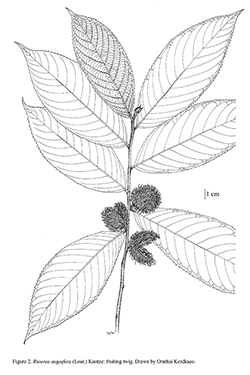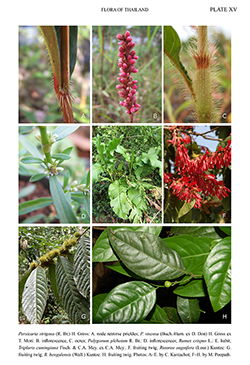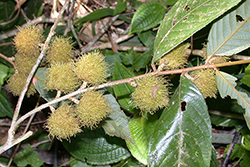e-Flora of Thailand
Volume 14 > Part 1 > Year 2018 > Page 157 > Violaceae > Rinorea
1. Rinorea anguifera (Lour.) Kuntzewfo-0000464490
Revis. Gen. Pl. 1: 42. 1891; Craib, Fl. Siam. 1: 88. 1925; Gagnep. in Humbert, Fl. Indo-Chine Suppl. 1: 187. 1939; M.Jacobs, Blumea 15: 127. 1967; M.Jacobs & D.M.Moore in Steenis, Fl. Males., Ser. I, Spermat. 7: 183. 1971.— Medusa anguifera Lour., Fl. Cochinch.: 406. 1790.— Juergensia anguifera (Lour.) Spreng., Anleit. Kenntn. Gew. ed. 2, 2(2): 806. 1818. Fig. 2. Plate XV: G.
Accepted Name : This is currently accepted.
Synonyms & Citations :
Description : Shrubs to small trees, 1–10 m high; twigs straight, terete, brown pubescent. Stipules not appressed, triangular, striate, caducous, 4–10 mm long, pubescent. Leaves alternate, lanceolate to elliptic, (8–)10–30 by (3–)4–8 cm, thin-coriaceous, pubescent; apex acute to acuminate; margin serrate; base acute to cuneate; midrib and primary veins flat above, prominent beneath; primary veins 9–14 pairs, curving approximately parallel towards the margin, without domatia in axils; secondary veins scalariform; petioles 2–8 mm long, brown pubescent. Flowers in dense axillary sessile to subsessile clusters on twigs and sometimes on branchlets; pedicels absent or very short; bracts 4–5 mm long, acute, pubescent; sepals 4–5 mm long, the inner ones narrower than the outer and slightly exceeding them, pubescent; petals white or yellow, 5–7 mm long, strap-shaped, the tip recurved, often the whole petal S-shaped, outside with pubescent median band; stamens with distinct filament tube; filaments sometimes hairy; anthers glabrous; dorsal appendage 1/3 of the anther’s length or shorter; ventral appendage none or vestigial; ovary obconical, hairy; ovules 6. Fruits globose, 1–3.5 cm in diam., mostly covered with densely long curly barbellate hairs, subtended by remaining dried sepals and petals. Seeds 3–6, ellipsoid, 3–6 mm long, straw-coloured, glossy.
Thailand : EASTERN: Ubon Ratchathani (Phu Chong Na Yoi NP); SOUTH-EASTERN: Chanthaburi (Kaw Klon – type of Alsodeia murtonii Craib: Murton 15 -K), Trat (Khao Saming, Khlong Yai, Ko Kut); PENINSULAR: Chumphon (Pha To), Ranong (Ngao Falls, Khlong Nakha), Surat Thani (Khlong Saeng WS), Phangnga (Si Phangnga NP), Phuket, Krabi, Nakhon Si Thammarat (Khao Luang NP), Trang (Khao Chong, Ton Tae Falls), Satun (Thalaebun NP), Songkhla (Boriphat Falls, Ton Nga Chang WS, Pa Krat Non-hunting Area), Pattani (type of Rinorea helicterifolia Craib, Kerr 7092 -BK E K), Yala (Betong), Narathiwat (Hala-Bala WS, Sukhirin, Waeng).
Distribution : Cambodia, Laos, Vietnam (type), Malaysia (Peninsula, Sarawak), Indonesia (Sumatra, Borneo), Brunei.
Ecology : Evergreen forests, dry evergreen forests, from near sea level to 700 m alt. Flowering and fruiting: almost throughout the year.
Vernacular : Dap chan (ดับชัน)(Chumphon); kriam (เกรียม)(Nakhon Si Thammarat); ngo pa (เงาะป่า)(Trat, Ranong, Narathiwat); prik (ปริก)(Trang).
Notes: The species is quite polymorphic in size and colour of leaves in the dried state and the degree of hairiness (subglabrous to densely pubescent) in all parts. It is characterized by axillary sessile or subsessile clusters flowers on twigs and the fruits with more or less long curly barbellate hairs. The species is currently being studies by DeMuria et al. in Geneva (G) and it may have to be further subdivided in the future. Schmidt 619d (C!), cited as Rinorea sp., in Craib (1925), is R. anguifera as determined by Jacobs (1967).



